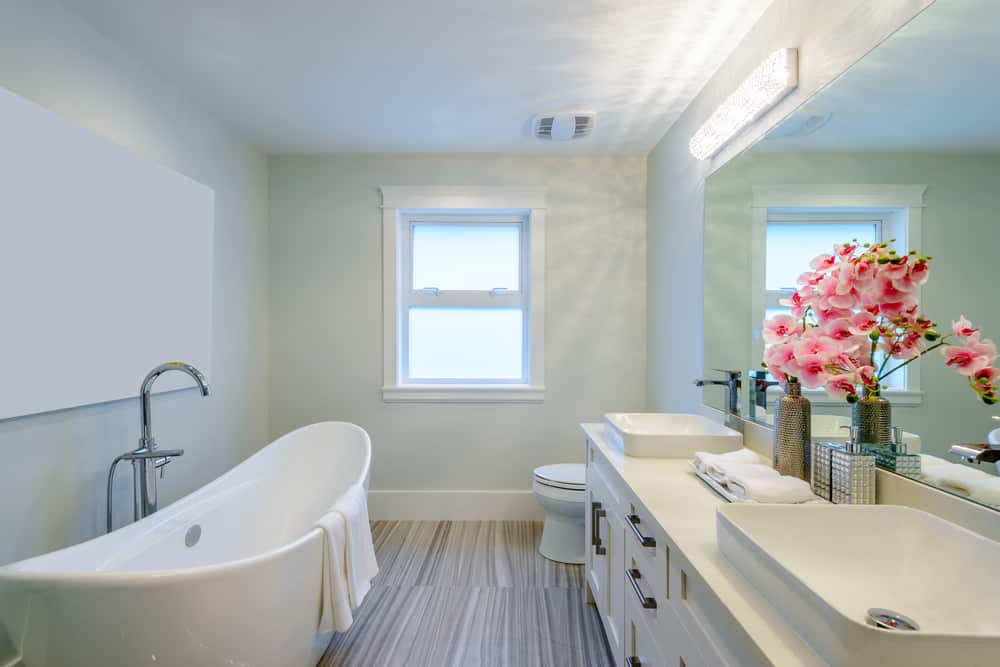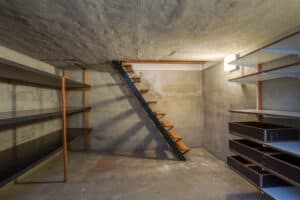
Every homeowner balances comfort and convenience with their budget when making decisions regarding the design of their home.
In order to save on money, many homeowners will wonder if certain common amenities, such as a vent in the bathroom, are a requirement or a luxury.
A vent in the bathroom helps keep the air clean and removes unwanted odors.
The plumbing system and the toilet can benefit from individual vents, too.
However, are they absolutely necessary?
We cover whether your bathroom and your toilet need a vent.
Does A Toilet Need A Vent?

Yes, residential building codes require all bathrooms to have adequate ventilation in the form of a window or, more desirably, an exhaust fan.
According to the IPC building code that applies to a vast majority of the country, the air from the bathroom must have ventilation that forces the old air outside so that new air can take its place.
It’s not enough to move the air around inside.
The air must be removed outdoors.
All bathrooms require adequate air ventilation, including half-bathrooms.
If you choose a ventilation fan, it must transfer air at a minimum rate of 20 cfm (cubic feet per minute) continuous or 50 cfm intermittent.
Most people choose an exhaust fan with a rating of at least 80 cfm intermittent, though.
Meeting the basic requirements may mean that your fan won’t qualify when the code is updated, so be careful about the decisions you make just to save a couple of dollars.
You need and want proper ventilation in all bathrooms to ensure clean-smelling and clean air in those rooms.
Bathrooms tend to experience high moisture levels thanks to the plumbing involved to operate the shower, sink, and toilet.
Plus, bathrooms are small, making ventilation more important here than in many other rooms.
Proper air circulation prevents mold development and other water damage.
Not only is restoration expensive, but the mold vapors in the air can be damaging to your skiing, eyes, and respiratory health.
It also keeps the air fresh in a small space that may be closed off at most times, leading to a more pleasant experience.
Full Bath Vs. Half Baths
A full bath refers to a bathroom with a toilet, sink, and tub or shower.
A half bath refers to a bathroom with only a toilet and a sink but no tub or shower.
Full baths tend to be larger since they have more fixtures, but they also produce more moisture.
Half baths tend to be smaller since they don’t have a tub or a shower.
However, the small space tends toward higher air contamination, even if you don’t have to worry about moisture from bathing.
As we mentioned, all bathrooms require air ventilation.
They both also require ventilation for the plumbing system.
Bathroom Air Ventilation Options

There are several ways to ventilate your option.
We will cover the different options and their advantages and disadvantages.
1. Windows And Ceiling Fan

You do have the option to ventilate your bathroom using a window.
The window must be large enough for the size of the bathroom (4% of the square footage of the bathroom and not any smaller than 1.5 square feet in size).
For the best results, bathrooms should be accompanied by a ceiling fan.
The ceiling fan helps circulate the air more effectively.
The ceiling fan may not be required, but it’s absolutely recommended.
Windows bring in fresh air, enhancing the experience and aesthetic appeal of the room.
They can also contribute to the interior design with thoughtful window sill and curtain selections.
Windows work especially well in bathrooms with light and flowery designs thanks to the additional natural light.
Window placement is especially important.
You need the window to be large enough to provide adequate ventilation while also not causing privacy concerns.
Don’t forget to include some sort of blinds or some other sort of privacy measure and keep the window somewhere easy for people to access in case they want to open or close it.
One major limitation to windows is that they can hinder your temperature control efforts in the summer and winter when the fresh air is too hot or cold for comfort.
That’s just one of the reasons most homeowners who include a window and ceiling fan also include an exhaust fan.
Another limitation is that most homes have neighbors nearby.
You don’t necessarily always want to open the window while you’re singing in the shower and getting ready in the morning.
2. Exhaust Fan
Broan-NuTone A80 Ventilation Fan with Roomside Installation, 80 CFM, 2.0 Sones White
An exhaust fan takes the air in the bathroom and transfers it outside.
It’s the fan that you hear when you turn on the designated switch in the bathroom.
There are two types of exhaust fans: a standard exhaust fan and an inline exhaust fan (also known as a ducted exhaust fan).
The main difference is that the inline exhaust fan includes a second duct.
While inline exhaust fans can be a little bit more difficult to install, they are the only appropriate option for homes with a flat or low-pitched roof.
The easiest exhaust fan to install is a simple model that installs into the ceiling.
However, there are many other ways to install the fan, depending on its functionality requirements as well as its different features.
Many exhaust fans for your bathroom will come with additional features, such as lights or heat.
In addition, many exhaust fans include loud noise to help ensure privacy in the bathroom.
You should not install an exhaust fan yourself unless you have the proper training.
If not properly installed, it can actually cause damage or make the quality of the air worse.
Plus, it won’t pass an inspection.
Additional Ways To Reduce Moisture And Improve Air Quality In Your Bathroom

Proper ventilation is the best way to ensure your bathroom air quality remains top-notch.
However, you can take action to promote clean air goals.
Try some of these tips.
1. Fix Leaks Immediately
If you notice a leak in your bathroom, you should take care of the problem immediately.
The most common places for a bathroom leak are the seal around the toilet, the bathroom sink faucet, the tub faucet, and the showerhead.
Leaks can also occur in the wall.
You can resolve many minor leaks yourself with some basic DIY plumbing techniques, such as replacing the cartridge in the faucet or caulking around the toilet.
Larger leaks or leaks deep in the main line may require the assistance of a plumber and possibly trenchless drain line repair.
2. Pick Up Your Mess
Mornings can get hectic for all of us, especially those days when we’re running a little bit behind.
Some people may accidentally leave their wet towels on the floor or fail to pick up the water they got on the floor during and after their shower.
However, this water doesn’t just disappear when you don’t pick it up.
The water soaks into the nearby surfaces, such as the floor.
Do your best to spend two minutes cleaning up the water and hanging the towels properly.
Don’t forget to extend the shower curtain after your shower to allow the shower curtain to dry and breathe properly.
3. Avoid Chemical Cleaners
Chemical cleaners work well when used properly, but harsh chemicals emit toxins (known as VOCs) into the air.
These chemicals are especially impactful in the bathroom due to the small area.
Try swapping out your chemical cleaners for all-natural alternatives or homemade solutions.
One of the most common homemade solutions involves a combination of baking soda and white vinegar.
Baking soda and vinegar can be made into a cleaning solution.
It can also be used as a drain cleaner that won’t damage your pipes as would a caustic drain cleaner.
4. Perform Proper Plumbing Maintenance And Best Usage Practices
Clogs develop in the bathroom in large part thanks to a buildup of hair, soap scum, toothpaste, and beauty products.
When clogs occur, it can lead to water buildup in your sink and tub.
If the clog is really bad, it may even lead to the sink or tub overflowing and spilling out, especially if there are no overflow tubes to remove excess water in the case of a running faucet.
A clog will also cause higher pressure levels in your plumbing system, potentially putting so much pressure on the material that it causes a leak.
Start by preventing clogs to the best of your ability by using a drain strainer in the shower and being careful about what you dispose of down the drain.
Even the most careful homeowners will experience a clog at some point.
However, you can reduce the size of the clogs with regular drain cleaning, such as Sani Sticks and enzymatic all-natural drain cleaners.
Venting Your Bathroom And Toilet

Not only does your bathroom require air ventilation, but the plumbing requires ventilation, too.
The toilet, sink, and tub must all have proper ventilation running into the system, which isn’t the same thing as the air ventilation system.
Your plumbing system requires proper airflow to maintain proper functions, as the air helps create the gravity that moves the water.
Every toilet in your home has its own ventilation.
Your sink has a particular type of drain trap known as a P trap.
The name comes from the shape of the fixture.
You will find the fixture underneath your sink rather easily.
While the P trap offers you a solution in case you drop something down the drain, that’s not its primary function.
It holds water that helps regulate gas in your pipes, regulating the airflow as well.
All sinks must have a P trap, but toilets should absolutely not have a P trap as they have their own internal trap.
Without proper airflow, you may notice that the toilet gurgles.
You will hear the gurgling in the sink if the P trap gets dry.
How To Vent A Toilet

If you do hear your toilet gurgling, you may need to vent the toilet or replace the current ventilation.
In order to do that, you will need to know a couple of things about toilet ventilation.
The standard toilet vent based on IPC code is 1.5” in diameter.
A connector known as a wye connects the vent pipe to the toilet’s trap.
The vent pipe, known as the toilet arm, cannot exceed 6” in length, according to the IPC.
The vent takeoff then removes air in a vertical direction to the proper ventilation system in your home or directly outside through the roof.
Conclusion
Yes. Your toilet needs a vent.
Not only does it need a vent to reduce moisture and odor in the air, but it also needs a vent to support proper plumbing functions.
Toilets all have a vent arm that connects the toilet trap to the home’s ventilation system or sends the air out of the house vertically through the ceiling.
Installing and repairing a toilet is considered an intermediate or advanced task, so only perform it yourself if you have the proper training.
Otherwise, consult with a professional plumber.
FAQs

1. What Happens If A Toilet Is Not Vented?
Proper airflow ensures that your plumbing system works properly.
Without proper ventilation, your toilet may not be able to drain properly.
This can potentially lead to a clog.
2. How Close Does A Toilet Need To Be To A Vent?
According to the International Plumbing Code, the toilet arm cannot be more than 6’ long.
3. Will A Toilet Flush Without A Vent?
Yes. The toilet will still flush, even if you don’t have it properly ventilated.
However, it won’t work as well as it would if it were properly vented.




Leave a Reply